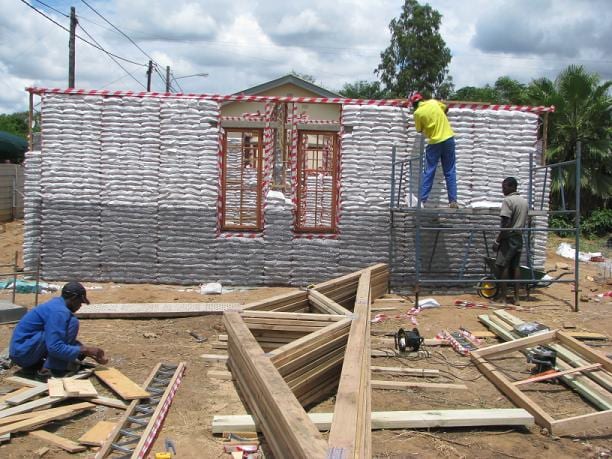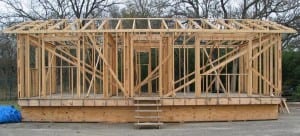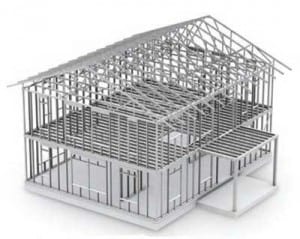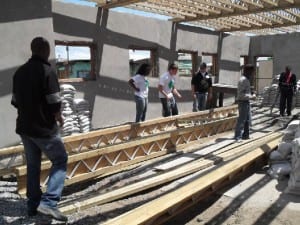Housing: Plan Implementation
Housing Report
Plan Implementation
Eco-Village Principles
It is important to use the most appropriate technology to solve today’s housing problems. Problems such
 as overcrowding, lack of opportunity and need for formal housing are continuous problems occurring in Monwabisi Park. In order to create a well-functioning housing plan, it is important to develop a sustainable solution that addresses these challenges. It is vital to create and expand innovative and long lasting solutions to the housing problems faced by countries all around the world. In Monwabisi Park it is especially important to create an environmentally and socially sustainable housing solution that can be implemented and managed simply. There is a need to provide affordable housing and a need to empower the community. One of the goals of a sustainable housing system is to reduce the environmental impact by making specific design choices and using eco-friendly building systems. Another goal of sustainable housing is to reduce the environmental impact by altering community choices and building systems in order to allow the creation of an eco-village. With better housing, one can protect the people of Monwabisi Park from the elements, have access to clean water and sanitation, and be energy efficient and environmentally friendly. This is crucial to Monwabisi Park because it will allow the community to thrive and sustain economically and structurally (BSHF information Leaflet, 2009).
as overcrowding, lack of opportunity and need for formal housing are continuous problems occurring in Monwabisi Park. In order to create a well-functioning housing plan, it is important to develop a sustainable solution that addresses these challenges. It is vital to create and expand innovative and long lasting solutions to the housing problems faced by countries all around the world. In Monwabisi Park it is especially important to create an environmentally and socially sustainable housing solution that can be implemented and managed simply. There is a need to provide affordable housing and a need to empower the community. One of the goals of a sustainable housing system is to reduce the environmental impact by making specific design choices and using eco-friendly building systems. Another goal of sustainable housing is to reduce the environmental impact by altering community choices and building systems in order to allow the creation of an eco-village. With better housing, one can protect the people of Monwabisi Park from the elements, have access to clean water and sanitation, and be energy efficient and environmentally friendly. This is crucial to Monwabisi Park because it will allow the community to thrive and sustain economically and structurally (BSHF information Leaflet, 2009).
Sustainable houses are self-sufficient structures based on simple living principles. Houses made to promote sustainable living focus on environmental and economic concerns. The Indlovu Project seeks to strengthen a community’s ability to thrive on the assets readily available to them. Sustainable building designs and development is a critical component to sustainable building structures. With these principles in mind, this community can become an eco-village. An eco-village is a community that is able to work, shop, and obtain the most basic needs within it, allowing the community’s economy to prosper. It would also create a sense of pride and unity amongst residents. In order to be successful, an eco-village requires some help to get started, cooperation of the community and basic instruction on how to maintain the system (Alex et al., 2007). Eco-villages are communities that strive to incorporate a supportive environment with the lowest impact and simplest way of life. In order to achieve these goals, one would integrate various aspects of eco-friendly design, permaculture, ecological building, green production, alternative energy and new building techniques (What is an eco-village, 2009).
With the right ideas, a complete plan and the implementation of this plan, an eco-village in Monwabisi Park is possible. By implementing an eco-village system, the community benefits from conservation of local resources, improved water resources, and improved infrastructure. Monwabisi Park would greatly benefit from any or all of these changes (Hu and Rusong, 1998). Another aspect of an eco-village is ecological and environmental concerns. These concerns can be addressed by creating homes out of recourses and materials that are readily available whenever it is possible. The newest technology can be used to create houses that conserve and recycle the energy that it uses. By preserving water and energy and by disposing of waste properly, the houses and the community will be able to be sustainable while protecting the environment at the same time (What is an eco-village, 2009). The concept of an eco-village meshes well with the community of Monwabisi Park. The community works together to meet common goals and everything in their culture has a great influence in their daily lives. The common goal is to implement new housing that will withstand time. By using new technology, a sustainable system can be placed into Monwabisi Park.
Technologies in Building
There are a variety of different building types and methods of construction. Determining a construction method should be one of the first decisions made before moving forward with preliminary designs. Following the principles of sustainability, it is important to choose a construction method that compliments the needs of the people as well as the surrounding environment.
 Wood framing, also known as light frame construction, is the most popular construction method in North America, Australia, and other countries around the world for many reasons. Wood frame buildings are typically built on concrete foundations. The foundation is laid and then the wood structural frame is built on the foundation. Interior and exterior wall coverings are later attached to this structural frame. Because wood frame buildings use relatively minimal structural materials, one can enclose a large space with minimal cost while still allowing for different ranges in style. This would not be an ideal building system to use in Monwabisi Park because wood framed buildings are prone to fires, of which the park has many. Also, with this building system there needs to be a firm foundation on which to erect the structure. This is needed to guarantee that the building is sound. In the community, the shacks and other building structures simply lie on sand. Where poor soil exists, like in Monwabisi Park, extra measures are taken to erect a sound foundation and building. Concrete foundations are used in places where engineers can analyze the footing. The need for this type of analysis increases the difficulty and price of construction. In addition, the skills needed for this type of construction consist of carpentry and other construction skills. Hiring people with these trade skills would increase the project cost exponentially. This building system is not recommended for Monwabisi Park for these reasons (Council, 2001).
Wood framing, also known as light frame construction, is the most popular construction method in North America, Australia, and other countries around the world for many reasons. Wood frame buildings are typically built on concrete foundations. The foundation is laid and then the wood structural frame is built on the foundation. Interior and exterior wall coverings are later attached to this structural frame. Because wood frame buildings use relatively minimal structural materials, one can enclose a large space with minimal cost while still allowing for different ranges in style. This would not be an ideal building system to use in Monwabisi Park because wood framed buildings are prone to fires, of which the park has many. Also, with this building system there needs to be a firm foundation on which to erect the structure. This is needed to guarantee that the building is sound. In the community, the shacks and other building structures simply lie on sand. Where poor soil exists, like in Monwabisi Park, extra measures are taken to erect a sound foundation and building. Concrete foundations are used in places where engineers can analyze the footing. The need for this type of analysis increases the difficulty and price of construction. In addition, the skills needed for this type of construction consist of carpentry and other construction skills. Hiring people with these trade skills would increase the project cost exponentially. This building system is not recommended for Monwabisi Park for these reasons (Council, 2001).
A nother building system is concrete buildings. This building system is a feasible option for Monwabisi Park. For the most part, the exterior of the building is built entirely from concrete. Because concrete is a heat sink, concrete buildings have an even temperature during the day and night. Temperatures within the building will feel cool during the summer and warm during the winter. This is a beneficial property in this community because Monwabisi Park faces many cold fronts, torrential rain fall and heat waves that can occur all within the same week. The fluctuation in temperature and weather is a critical problem that needs to be addressed. This is a useful aspect of concrete because many of the shacks and other structures in Monwabisi Park currently experience heating and ventilation issues. Furthermore, concrete is a rigid material and allows for more stability than a wood frame structure. If properly reinforced, concrete structures can withstand earthquakes. This makes it an ideal choice for high force wind areas. All in all, the total construction cost is only slightly above that of wood frame building. Because of the higher building cost and the need for skilled labour, this building system was not found to be the best system for Monwabisi Park (Cement, 2009).
nother building system is concrete buildings. This building system is a feasible option for Monwabisi Park. For the most part, the exterior of the building is built entirely from concrete. Because concrete is a heat sink, concrete buildings have an even temperature during the day and night. Temperatures within the building will feel cool during the summer and warm during the winter. This is a beneficial property in this community because Monwabisi Park faces many cold fronts, torrential rain fall and heat waves that can occur all within the same week. The fluctuation in temperature and weather is a critical problem that needs to be addressed. This is a useful aspect of concrete because many of the shacks and other structures in Monwabisi Park currently experience heating and ventilation issues. Furthermore, concrete is a rigid material and allows for more stability than a wood frame structure. If properly reinforced, concrete structures can withstand earthquakes. This makes it an ideal choice for high force wind areas. All in all, the total construction cost is only slightly above that of wood frame building. Because of the higher building cost and the need for skilled labour, this building system was not found to be the best system for Monwabisi Park (Cement, 2009).
 A third building style is steel framing. The benefit of using steel is its durability and resistance to change. Steel does not shrink, split, or warp. Since quality is consistent and the beams are usually made to size, there is minimal scrap material relative to wood structures. Steel is resistant to rot, mold, and insect infestation. For these reasons, steel frame structures have a relatively low maintenance cost. Steel is considered a “green” material because it uses twenty five percent recycled materials and is one hundred percent recyclable. As with anything, there are a few downfalls to using steel. First, not all builders are familiar with constructing metal structures, have knowledge in the latest standards and have knowledge of the latest computer software. Special tools are needed in the construction of steel buildings as well as special designs that properly brace the steel. The greatest disadvantage with steel structures is that they are a great conductor of heat meaning that they gain heat very quickly and lose it just as fast. For these reasons, steel is not an ideal building material to be used in Monwabisi Park. Two other reasons that steel is not ideal are that the cost of steel is much greater than the cost of other building materials as well as the man-power and materials that it would take to build and insulate a building with steel framework. Even though steel is a strong material and could withstand the high speed winds of Monwabisi Park, it would not be ideal to implement (A Builder’s Guide to Steel Frame Construction, 2007).
A third building style is steel framing. The benefit of using steel is its durability and resistance to change. Steel does not shrink, split, or warp. Since quality is consistent and the beams are usually made to size, there is minimal scrap material relative to wood structures. Steel is resistant to rot, mold, and insect infestation. For these reasons, steel frame structures have a relatively low maintenance cost. Steel is considered a “green” material because it uses twenty five percent recycled materials and is one hundred percent recyclable. As with anything, there are a few downfalls to using steel. First, not all builders are familiar with constructing metal structures, have knowledge in the latest standards and have knowledge of the latest computer software. Special tools are needed in the construction of steel buildings as well as special designs that properly brace the steel. The greatest disadvantage with steel structures is that they are a great conductor of heat meaning that they gain heat very quickly and lose it just as fast. For these reasons, steel is not an ideal building material to be used in Monwabisi Park. Two other reasons that steel is not ideal are that the cost of steel is much greater than the cost of other building materials as well as the man-power and materials that it would take to build and insulate a building with steel framework. Even though steel is a strong material and could withstand the high speed winds of Monwabisi Park, it would not be ideal to implement (A Builder’s Guide to Steel Frame Construction, 2007).
ecoBEAM
 EcoBEAM Technologies was created by Mike Tremeer as a low-cost sustainable housing solution. An ecoBEAM is part of a building system that is being implemented in the redevelopment of Monwabisi Park. EcoBEAMs are constructed using two pieces of timber connected with a metal lattice framework in between. Another integral part of the ecoBEAM system is the sandbag. Sandbags are the sustainable foundation of this technology because sand is a common resource and can be found almost anywhere. These sandbags are placed within the ecoBEAM framework to create the walls of the building. Once the sandbags have been laid, the walls are then covered with plaster. Further detail on how to construct a building using ecoBEAM Technologies can be found in the ecoBEAM Building Manual.
EcoBEAM Technologies was created by Mike Tremeer as a low-cost sustainable housing solution. An ecoBEAM is part of a building system that is being implemented in the redevelopment of Monwabisi Park. EcoBEAMs are constructed using two pieces of timber connected with a metal lattice framework in between. Another integral part of the ecoBEAM system is the sandbag. Sandbags are the sustainable foundation of this technology because sand is a common resource and can be found almost anywhere. These sandbags are placed within the ecoBEAM framework to create the walls of the building. Once the sandbags have been laid, the walls are then covered with plaster. Further detail on how to construct a building using ecoBEAM Technologies can be found in the ecoBEAM Building Manual.
According to the ecoBUILD website, a house framed with ecoBEAM uses two thirds of the lumber a typical wood frame house would and thus reduces the cost twenty to thirty percent. The technology is an environmentally friendly and cost effective alternative to other more conventional building materials. Another beneficial attribute is the thermal properties of ecoBEAM buildings. Much like concrete buildings, the sandbags provide the insulation needed to keep houses cool during the summer and warm during the winter months. This makes ecoBEAM Technologies a natural fit for the redevelopment efforts in Monwabisi Park (ecoBEAM, 2009).
 Professional knowledge of building techniques is not required to construct an ecoBEAM house. Therefore, with the supervision of one knowledgeable foreman, the community members of Monwabisi Park can be self-sufficient in providing the materials and labour necessary for construction. The implementation of ecoBEAM Technologies creates many job opportunities such as manufacturing beams, sewing sandbags, and building the houses. In addition to only requiring unskilled labour, ecoBEAM technologies also uses minimal tools and does not require on site electricity. EcoBEAM buildings can be built virtually anywhere.
Professional knowledge of building techniques is not required to construct an ecoBEAM house. Therefore, with the supervision of one knowledgeable foreman, the community members of Monwabisi Park can be self-sufficient in providing the materials and labour necessary for construction. The implementation of ecoBEAM Technologies creates many job opportunities such as manufacturing beams, sewing sandbags, and building the houses. In addition to only requiring unskilled labour, ecoBEAM technologies also uses minimal tools and does not require on site electricity. EcoBEAM buildings can be built virtually anywhere.
Presently within Monwabisi Park, the shacks are prone to fires from unsafe fuel sources and unofficial, informal electrical grids. While these problems should certainly be addressed, the ecoBUILD system is fire resistant. For the reasons outlined above, this report will focus on ecoBEAM Technologies as our chosen method for construction. Monwabisi Park has much to gain from the implementation of the ecoBUILD system (ecoBEAM, 2009).
Next Section: Design Considerations
Back to: Housing Report
Author: WPI CT09 Buildings


